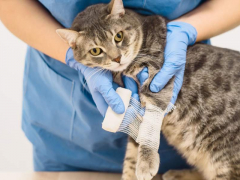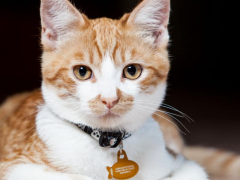Properly cleaning your cat’s litter box keeps your cat happy, can prevent litter box avoidance, and ensures that your home smells fresh no matter how many cats you have. In this article, you’ll get 10 expert tips and tricks to teach you how to clean your cat’s litter box like a pro.
How To Set Up Your Cat’s Litter Box?
It’s common for people to not have enough litter boxes for their cat(s) and the boxes provided are often too small. These factors contribute to the cleanliness of the boxes, so to start, let’s talk about setting up your cat for success when it comes to litter boxes.
1. Choose a litter box that’s the right size.
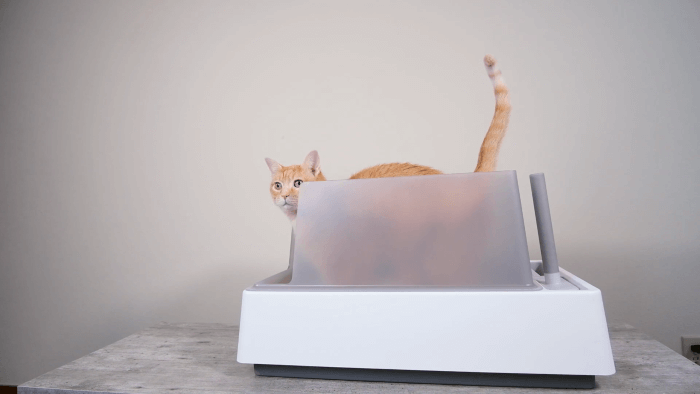
Choose a litter box that is the right size for your cat. It should be big enough for your cat to turn around in and contain both litter and waste.
Size does matter when it comes to litter boxes – bigger is always better. Even the so-called “large” litter boxes sold in pet supply stores are too small for most cats.
When choosing a box, your cat should be able to comfortably turn around in the box and, ideally, the box should be at least 1.5 times the length of the cat from nose to the base of the tail. Under the bed storage containers, 30-gallon storage containers, and cement mixing tubs are a few appropriately sized alternatives to their small commercial counterparts.
When choosing boxes for small kittens, declawed, or senior cats, it’s recommended to use low-sided boxes, or purchasing a storage container and cutting a low entry so that the cat can easily walk in and avoid lifting their legs high or jumping in, which can be painful. Most cats are not fond of covered boxes for a variety of reasons.
Editor’s note: Cats.com doesn’t support declawing in any way shape or form. Declawing your cat can cause your furry friend a lot of pain and suffering.
These boxes are often too small, and they trap odors and dust inside, which is very unpleasant for the cats. Cats are both prey and predator animals. Since cats are prey animals, asking them to go in a covered box where, from a cat’s perspective, they cannot see possible predators and are made to feel exposed to threats is not ideal. A transparent or translucent litter box can be helpful to make cats feel safer.
2. Provide the right number of litter boxes in the right locations.
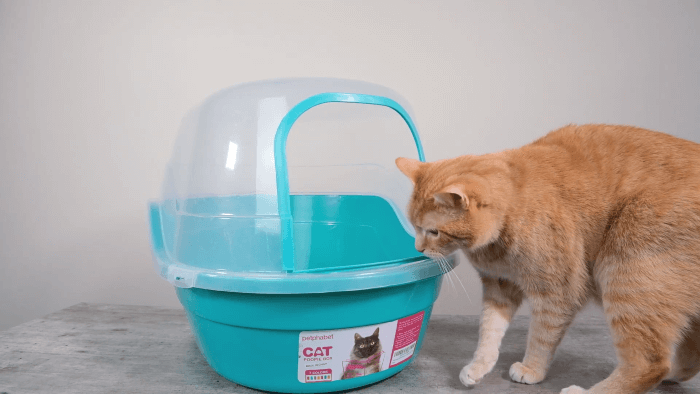
Even if you have only one cat, it’s important to provide enough litter boxes so that your cat (or cats!) have options to choose from and a relatively clean place to go.
The golden rule for the number of litter boxes in a house is one box per cat plus one. But getting the right number of litter boxes isn’t enough. Placement is vital, too.
Remember, three boxes right next to each other are considered one box from a cat’s perspective. So where should you place your litter boxes?
The location of your cats’ litter boxes is key in preventing litter box aversion and accidents. Here are a few tips to help you find the perfect places for your cats’ litter boxes:
- Don’t place litter boxes in the same area as your cat’s food and water. You would not want to eat where you use the restroom, and neither does your cat.
- Choose quiet, private places. Cats prefer to use their boxes in quiet and private places. When placing litter boxes, avoid high traffic areas and locations where a cat could be cornered or unable to flee (for example, if the box is in a closet where another cat or dog can block the exit). Frequently, people place litter boxes in the laundry room, but these areas are not ideal. Washers, dryers, and furnaces are all loud appliances that turn on randomly. If a furnace kicks on when the cat is in a box, this can scare them and cause them to associate the litter box with a negative situation.
- If you have a multi-level home, place a litter box on every floor of the house.
- While quiet, secure places are best, remember that your cat wants to be around you. Remember when placing all resources, cats bond with their owners and want to be with them. Resources should be available throughout the home including in areas the owners spend most of their time.
3. Use the type of litter your cat prefers.
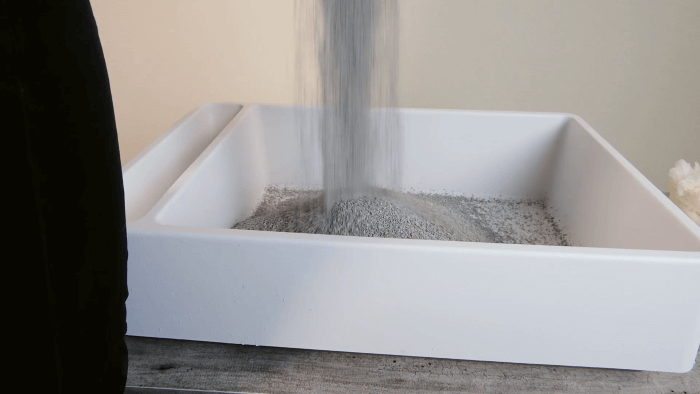
Cats prefer fine-grained, clumping cat litter. Either a clumping clay or biodegradable product will do. Avoid scented litters, as these tend to be irritating to cats’ sensitive noses.
Based on research, cats prefer soft, unscented cat litter that clumps.
Also Read: The 12 Best Clumping Cat Litters
Cats have an instinct to bury their waste to avoid attracting predators and will look for a soft, loose substrate that’s easy to dig into. For this reason, fine-grained clumping clay or biodegradable products are generally feline favorites.
Cats have a strong sense of smell (about 14 times stronger than a human’s), and scented litter can be very unpleasant to most cats.
This is also a good reason to avoid using litter deodorizers or air fresheners near the litter box. It can be tempting to use these to control litter box odor, but remember that odor should not be a problem if you are using the right litter and keeping the box clean.
It’s recommended to stick with what cats prefer. If your cat prefers a specific litter, try not to change it.
How To Clean Your Cat’s Litter Box?
1. Scoop the litter box one to two times daily.
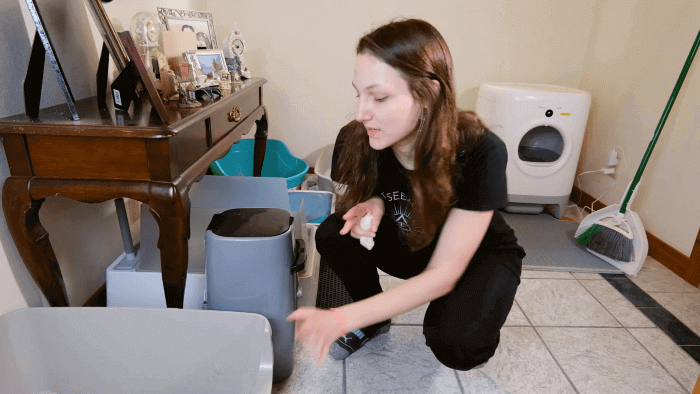
Clean your cat’s litter box at least once every day. Regular, consistent scooping is the single most important part of keeping your cat’s litter box clean and preventing litter box avoidance.
Ideally, you should scoop litter boxes once to twice daily. This helps to keep the litter box clean and prevents odor. It is also helpful to observe what you find in the litter box as an assessment of your cat’s health including how often and if they are going.
If bending over is difficult for you, I recommend a cat litter scoop with an extended and adjustable handle which will prevent the need to bend when scooping and can be used while sitting in a chair.
To help keep this task manageable, you will want to get a litter scoop, which has little slats that allow litter to fall out, separating the larger clumps which can be tossed. Aluminum litter scoops that are deep and wide are best because they are durable, won’t rust, and making scooping easier.
Tips for Successfully Cleaning Your Cat’s Litter Box
- Before you start scooping, lift up one end of the litter box and tap the side to release any clumped litter that’s collected in the corners or on the side. With the litter box tilted, you can easily see any stuck-on waste and remove it before moving through the rest of the litter.
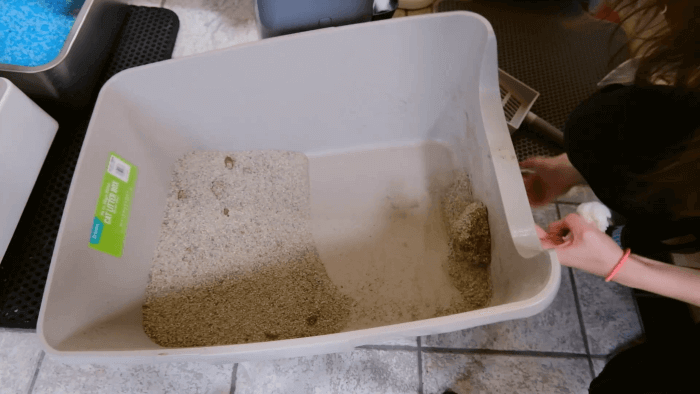
- Once you’ve removed any stuck-on waste, use a baby wipe or pet wipe to remove anything residue from the surface of your litter box.
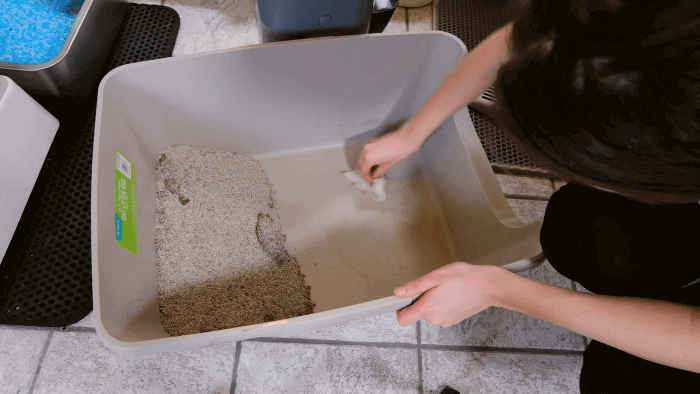
- Move from one end of the box to the other, moving in methodical rows. Think of it a bit like shoveling snow from a sidewalk. Once you’ve cleaned out one row, scoop the next.
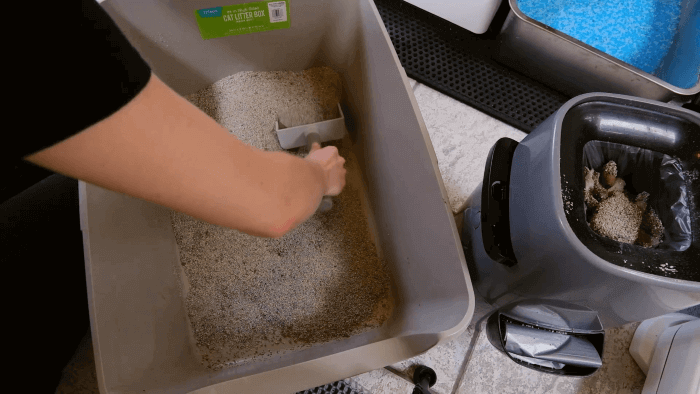
- Repeat the tilting process on the other side, knock out any clumps, and wipe to remove any residue. Then go through and scoop one more time to make sure you’ve removed any lingering particles.
2. Discard the waste in an appropriate receptacle.
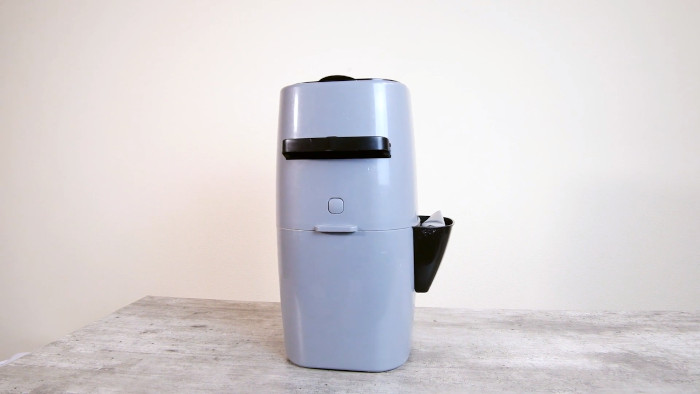
After scooping out the litter box, all waste must go into an appropriate receptacle. You can use a simple bag or a product like the Litter Genie (pictured above).
Waste should go into a bag that is tied up and put into the trash. Grocery bags work great for this! You can also use kitchen trash bags or wastebasket liners.
If you’ll need to store the waste in your home for a while before it goes out to the dumpster, you may be interested in a product like the LitterLocker or Litter Genie. These products are designed to hold litter and control waste odor for longer periods of time. On garbage day, just remove the bag and contents and discard in the garbage can.
3. Wash your hands and arms thoroughly.
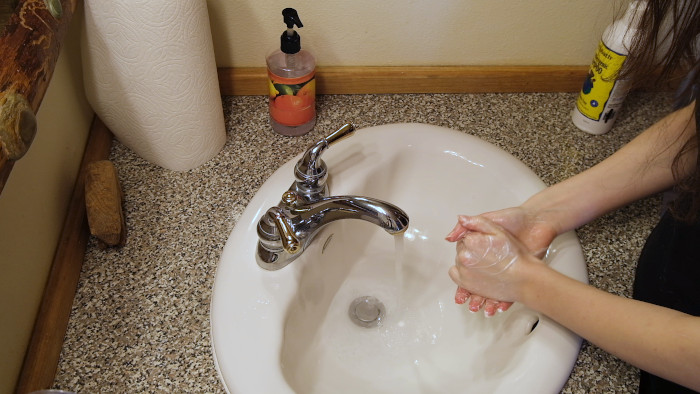
After you’ve cleaned your cat’s litter box, wash your hands and arms thoroughly. This helps to prevent the spread of T.gondii, a parasite often found in cat feces.
After you’ve scooped and discarded the waste, you’ll want to wash your hands and arms thoroughly. Not only is cat waste and litter messy, it’s potentially harmful to sensitive populations.
Cat feces may carry a parasite called toxoplasma gondii. While healthy adults generally don’t experience illness from toxoplasmosis, an infection can be very harmful to immunocompromised adults and developing fetuses.
Because T. gondii is so dangerous to human fetuses, pregnant women should avoid cleaning the litter box at all. If you are pregnant and absolutely must clean the litter box, be sure to wear disposable gloves, and don’t touch anything until you’ve discarded the gloves and thoroughly washed both your hands and forearms.
How Often Do You Need to Deep-Clean the Litter Box?
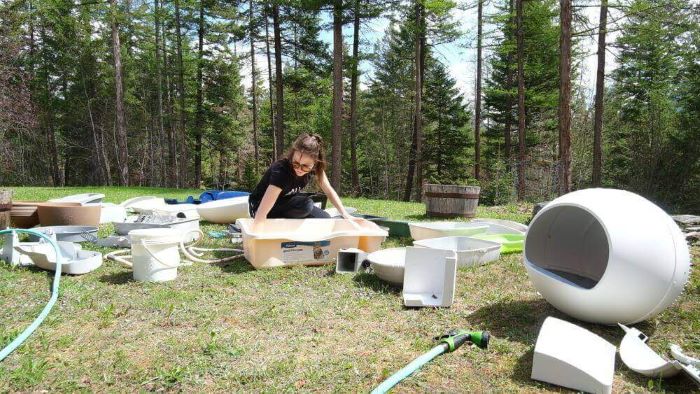
On a regular basis, you should remove all of the litter from your cat’s litter box and clean it thoroughly.
In addition to daily scooping, it’s recommended to empty all the contents of a litter box, clean the litter box, and refill with fresh litter on a regular basis. How often you’ll have to do this depends on the type of cat litter you’re using and how thoroughly you clean it.
If you’re using a clumping clay litter, you’ll generally want to change it out every 4-6 weeks.
A box with non-clumping clay or plant-based litter should be changed completely more often. If you’re using a non-clumping litter, you’ll want to change it out every week or less.
Crystal litter doesn’t clump, but it is generally able to retain more moisture before it needs to be changed out. In general, crystal litter should be changed out every 3-4 weeks per cat.
When cleaning, avoid strong aversive cleaning agents like bleach and instead use a mild, unscented detergent. Avoid abrasive cleaning tools like steel wool and opt for softer sponges or cloths that won’t create scratches.
When replacing the litter, most cats prefer 2-4 inches of litter. Whatever the depth, try to keep it consistent.
When Should I Replace the Litter Box?
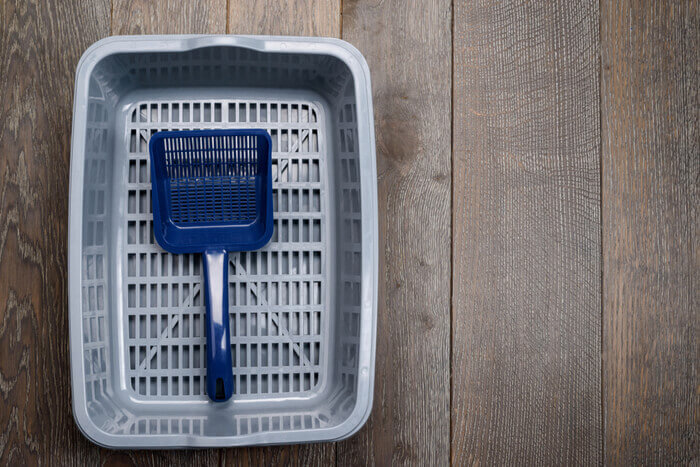
You should replace your cat’s litter box at least every one to two years. This helps to ensure that there are no lingering odors from long-term buildup.
You should replace litter boxes at least every one to two years. Factors that contribute to this are litter box durability, wear and tear, number of cats, how many boxes you have, and your cat’s individual needs.
Signs that you should replace a litter box include:
- Visible scratches throughout box which can trap odor and waste matter
Plastic breakdown, over time, the plastic will become brittle and can begin to break apart - Unremovable odors
- Clouded plastic, depending on the color and type of plastic you have
- Any changes in the color of the litter box
How Should You Clean up Accidents?

If your cat has made a mess outside of the litter box, use an appropriate product to clean it up thoroughly.
When cleaning areas of housesoiling, you should first blot up as much urine as you can with paper towels, and then follow up with towels soaked in warm water to wipe away the rest of the smaller residue.
Avoid cleaning products containing ammonia or vinegar as they smell similar to urine and can be irritating. Instead, use an enzymatic cleaner. The enzymes in these products break down the acid in cat urine, helping to get rid of the smell at the same time.
My favorite products are Urine Off, Anti-Icky Poo, and Veterinary Strength Outright Stain & Odor Remover. A blacklight can be a helpful tool to check for residual or old stains so you can clean appropriately and be aware of where your cat is having accidents.
Read More: Top 10 Best Cat Urine Removers
How Do You Keep the Area Around the Box Clean?
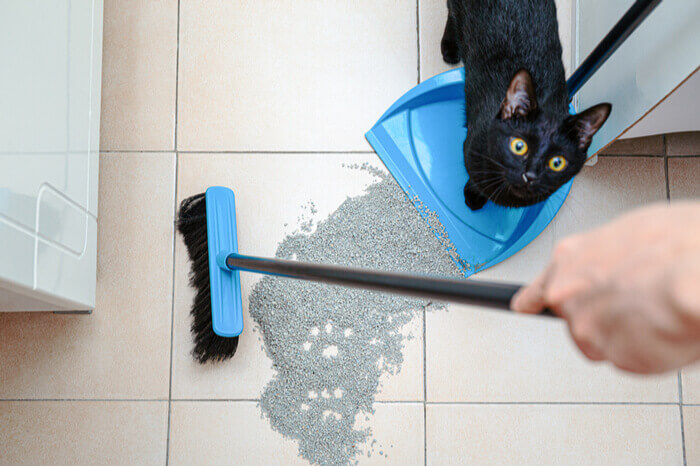
Cleaning up around the litter box is a key part of maintenance. Use a good litter mat to prevent spills from getting on your floor, and keep a broom and vacuum nearby to clean up anything that the mat can’t catch.
Part of your routine litter box cleaning schedule should include cleaning around the box. This may be vacuuming the area if you have carpet or sweeping and mopping. Litter mats can be helpful to place under the box to help trap small pieces of litter that naturally track out of the box on your cat’s paws.
Another tip to help minimize litter outside of the box, having a big enough box also helps. Many boxes in stores are too small and the cat needs to step out to do the normal scooping behavior which results in a lot more litter outside the box.
I love using yoga mats as litter mats, you can cut them down to make numerous mats, they work great to catch excess litter, easy to clean and very cheap, and can get colors to match your décor.
What if Your Cat Is Not Using the Box?
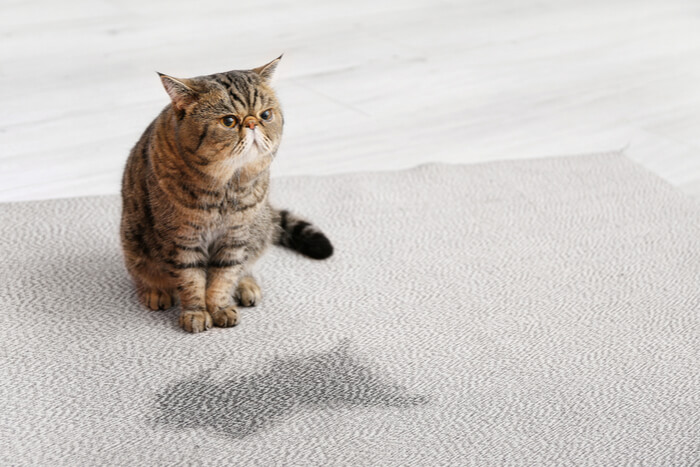
If your cat goes outside of the litter box repeatedly, it could indicate emotional or physical problems. Don’t assume that your cat is angry or trying to punish you—this simply isn’t how cats work!
Ask for help! Cats defecating and urinating outside the box is one of the most common behavior issues among cats. Contrary to popular opinion, cats do not do that to punish or spite their housemates! Instead, feline house-soiling is due to either a medical problem and/or fear, anxiety, and stress.
If your cat begins to not use the box, reach out to your veterinarian to address medical issues and certified behavior professionals for help.
Cat Guardian Academy’s litter box acceptance course can also help.
Hosted by cat behaviorist Rachel Geller, Ed.D, this course was developed to help you resolve litter box avoidance and help your cat love the box. The course is 100% free and available for you to take at any time.
Click here to sign up for free.
